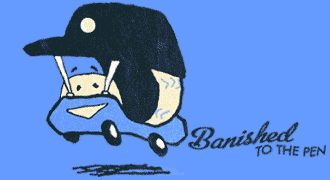Our new weekly podcast kicks off with Very Special Guest Ben Lindbergh, of Effectively Wild and Grantland fame! Host Ryan Sullivan chats with Ben about being a baseball writer, and everything you wanted to know about EW.
The Banished to the Pen podcast is hosted by Ryan Sullivan. Each week, Ryan will chat with various site contributors to talk all things baseball.
The Cincinnati Reds traded for Marlon Byrd last week. That’s not the most exciting sentence in the world is it? The response on social media was equally lackluster. It’s not that people ignored the trade, but it seemed to leave everyone feeling a little indifferent. This trade felt a lot like the argyle socks that you got for Christmas two weeks ago – you weren’t terribly excited about them, but you did need to replace a few pairs with holes in them.
Voting for the 2015 MLB Hall of Fame class has ended, and soon we will know who will be inducted into the hallowed halls of Cooperstown. Over the next few weeks you’ll hear pundits and… Read more »
I found something peculiar while researching the career performance of those likely first-ballot Hall of Famers – Randy Johnson, Pedro Martinez and John Smoltz. One player who will certainly not be a Hall of Famer, who was very familiar to me as Mets fan with my formative years in the late 1990’s to early 2000’s, kept appearing. It was none other than Pat Mahomes.
I haven’t posted here at Banished to the Pen in, wow, it’s been nearly three weeks. This is a short post about my absence, my return, and the stray thoughts reentering the work flow here has… Read more »
A lot of St. Louis Cardinal fans, myself included, were a bit surprised when Sierra was selected as the Cardinals’ Minor League Player of the Year last month alongside Marco Gonzales, who was given the same award for pitchers. Surprised because other than hearing his name in passing a few times, I really didn’t know much about him. Unlike Gonzales, who made his debut on June 25th and had an established role with the club during the 2014 postseason, Sierra seemed to have sprung up from nowhere.

“The Jays have their Rogers ‘homer’ Centre, the Yankees have a little-league-calibre right field porch, Camden Yards in Baltimore also helps run scoring, as does Fenway Park’s 37-foot high, 231-foot long Green Monster. So, for example, when we hear Rick Porcello is headed to Boston, that only means trouble, right?”
“The transition from player to coach is often a difficult one with numerous components factoring into a successful move from the playing field to the dugout and backfields. For many, the passion and drive to perform on the field are still present, but the body sometimes breaks down and an eroding skillset often betrays the player. Becoming a good coach won’t happen until one is able to put their playing days in the rearview mirror.”

In the conclusion of our 7-part series, Matt Jackson and Darius Austin recap the Royals and Giants’ 2014 playoff series and 7-game World Series matchup.
I will not be attending the 1990 Spring Training Camp of the team of my choice.
“This post goes along with my previous post in which I found that ‘…an All-Star selection can increase a player’s salary significantly; on average by $1,517,550.’ What I did not demonstrate there, but intend to explain here, is how that increase in a player’s salary the year after an All-Star selection relates to their statistical performance in that same year.”
“It’s been a great holiday season for all of us here at Banished to the Pen! Our Secret Santa exchange resulted in only minor injuries that, at worst, will leave a few staffers day-to-day. And the Party Planning Committee’s appeal of their suspension has a very good chance of being reduced! So as this time of giving comes to a close, here’s some kind words you gave to us (although, again, it often involved trying to sell us things…).”

“Much has been made of the fact in Redsland that Joey Votto doesn’t seem to have the power that he used to. Most fans point to the fateful collision with Pablo Sandoval back on June 29, 2012, and the numbers seem to bear that out.”
“I wanted to try and collate some interesting things together that tangentially bring together my favourite holiday and my favourite sport. I originally wanted to take a look at players with funny Christmas-based names, or make up a festive team, but baseball-reference beat me to it. Instead, I figured I’d look at pitchers in 2013 & 2014 about whom you could start to read far too much into their performance, and determine if they’d been naughty or nice, as per the great Christmas parenting behaviour technique.”
“Although the 2015 season is still months away, it doesn’t hurt to look ahead, or in a sense look back. In this instance, I wanted to throw some red flags on players who may have been fortunate in 2014.”

“I am fascinated with MLB player salaries (all sports salaries for that matter), and I wanted to know if it was worth anything to the player to be selected to an All-Star team. I know players typically have incentives built into their contract for achievements such as this, but they usually fall under the category of a one time bonus. What about their actual salary? Is it affected if the player makes an All-Star team?”
“My first major league baseball game was in April of 1987, in St. Louis, Missouri. I was eight years old. My favorite team calls St. Louis home and on that Saturday night we, the Cardinals, were playing the New York Mets. This was serious business. True, our rival was, and is, the Chicago Cubs, but that wasn’t really the case in 1987. The Cubs were “lovable losers,” they were cute. The Mets were not cute. They were brash, they were reckless, and they had a slugger named ‘Howard Johnson’ which I thought was weird. And more importantly, they were winners.
“Last week, Trea Turner was not traded from the Padres to the Nationals. He wasn’t traded because players can’t be traded until a year after they signed – June 13, 2015 in Turner’s case. The asset that was included in the deal was a player to be named later (PTBNL). PTBNLs don’t need to be named until six months later. Conveniently, Turner would be eligible to be traded at this point. (Of course, it was Turner in the trade – I’m just pointing out the technicality).”

From the episode notes: “Ben and Sam answer listener emails about the importance of coaches, defensive stats, and how we know whether pitchers should gain or lose weight, with guest appearances by Colin Wyers and Doug Thorburn.”

Ever wonder which university has produced the highest-paid baseball players? This is a list of the total salaries of all MLB players that attended each NCAA university from 1985-2013 ranked from highest to lowest. This does… Read more »

“Whenever a new coach takes over a team, there is a power struggle. Players jostle for depth chart positioning, recognizing the clean slate that can erase prior misdeeds or accomplishments. They also jostle for positioning with their coach, because for a few years, the returning players actually have seniority over their new skipper. Determining who calls the shots can sometimes be a bloody and protracted battle.”

“The best cards are often when the manufacturer didn’t seem to care whether the player knew his picture was being taken or not. This seemed to afflict the more average players than your all-stars. Honestly, I could make an entire 700-card series of these. “
“It’s been nearly two months since the Royals lost the World Series by ninety feet. Baseball went into hibernation when Fox signed off that night, not to be heard from again until April, right? Of course not, although we do get a welcome respite from Joe ‘Hack’ Buck and Harold ‘Hack’ Reynolds. Baseball is a 365-day-a-year sport (366 in leap years). There are plenty of ways to get your baseball fix in the winter.”
“San Francisco halted their slide in the second half and kept the division competitive for the remainder of the season without ever reaching those early heights again. Although they couldn’t overturn the deficit to the Dodgers in the final weeks, a 35-31 second half was enough to take the second wild card with an 88-74 record.”

Dayton Moore continued his assault on the free-agent market by signing right-handed pitcher Kris Medlen, who sat out all of 2014 following his second Tommy John surgery. The talented 29-year-old will earn $2 million in 2015 and $5.5… Read more »

Royals GM Dayton Moore remained active this month, signing free-agent starting pitcher Edinson Volquez to a 2-year, $20-million contract. The 31-year-old Dominican Republic native will fill the spot previously occupied by James Shields in the rotation, joining… Read more »
“The fortunate few get to root in person for their hometown team in a World Series. Brian Daubach, who grew up twenty miles from St. Louis, lived out that dream as a 10-year-old boy, attending a game during the 1982 Fall Classic as the Cardinals took on the Milwaukee Brewers. He thought it would be the highlight of his baseball life. He was wrong.”
“The Baseball Hall of Fame—as a museum and a process by which former players (and others) are enshrined—is more art than science, and more kitsch than authentic. This is something to keep in mind as you read about the Hall of Fame voting this month. You’ll read a lot about capricious voting, sanctimony, and cheating. Emotional and seemingly arbitrary voting is nothing new.”



